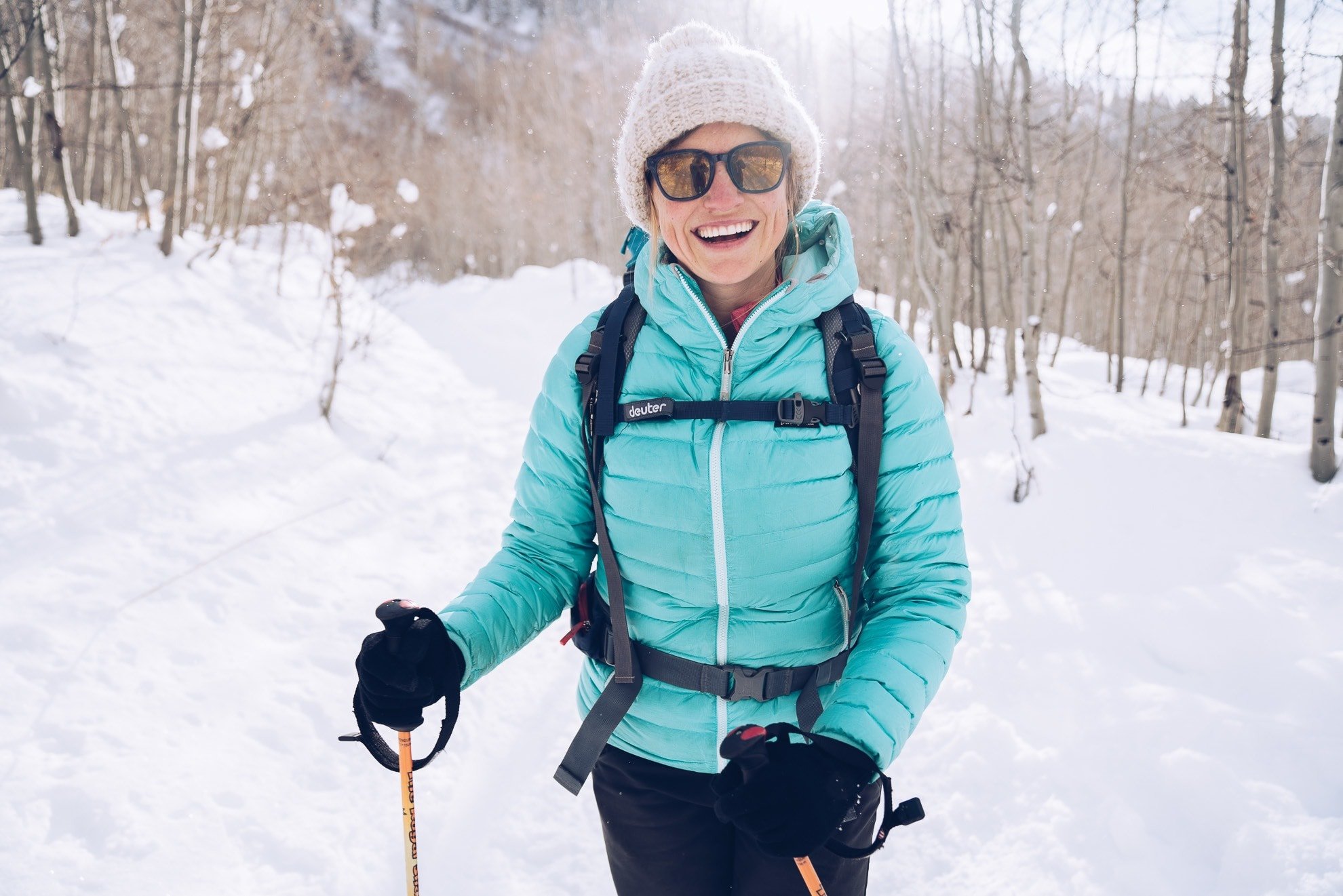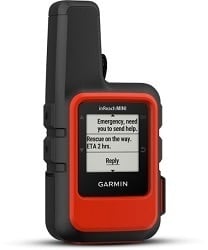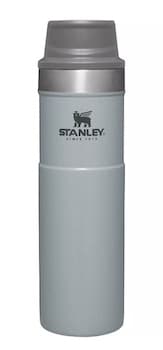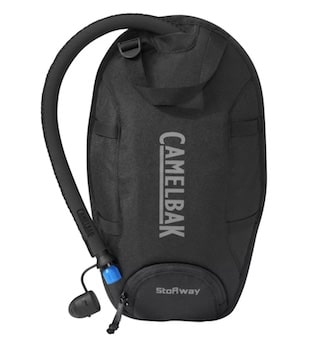As the times get shorter and the climate will get colder, it’s straightforward to lose the motivation to get exterior. It’s not as easy to go outdoor in winter as it’s within the hotter months when you may simply throw in your sneakers and hit the path.
But, with a shift in your mindset and these winter climbing ideas, climbing in winter is definitely actually enjoyable and might even increase your temper and enhance your psychological well being. Spending the final 7 winters in Utah, I’ve personally discovered winter climbing to be an effective way to remain energetic and wholesome in the course of the darker months after I would possibly in any other case really feel inclined to hunker down in entrance of the television.
Whether you’re winter’s largest fan or not, I need you to really feel snug getting exterior and having fun with all 4 seasons. Here are my finest winter climbing ideas and really useful winter climbing gear for staying energetic and getting exterior within the snow!
Sponsored by Public Lands
Public Lands is a brand new out of doors retailer centered on serving to extra individuals get exterior to discover and defend America’s public lands. They carry a few of my favourite out of doors manufacturers and have the whole lot it’s essential to get equipped on your subsequent climbing, tenting, or winter journey. They are additionally members of 1% for the Planet, which implies they donate 1% of their annual gross sales to environmental-focused non-profits.
Basic Winter Hiking Tips
Hiking in winter requires extra planning than a daily climbing tour as a result of it’s essential to take further security precautions to arrange for the tough components. Here are some primary ideas for getting began with climbing within the snow.
1. Look up winter path circumstances
When selecting the place to go winter climbing, one of many first belongings you’ll have to do is search for present path circumstances. Many trailheads aren’t accessible in winter, so that you’ll need to be sure to can get there safely in your car.
Be certain to verify snow circumstances and climate earlier than leaving the home as nicely. If it’s a blizzard with poor visibility, it will increase your possibilities of getting misplaced…so possibly it’s not the most effective day to go climbing. When unsure, don’t exit.
The path circumstances may also decide what kind of winter climbing gear you want. If the path is well-traveled with hard-packed snow, you may hike in winter climbing boots and a pair of microspikes. If the path shouldn’t be compacted, then you might want snowshoes to keep away from sinking into the snow.
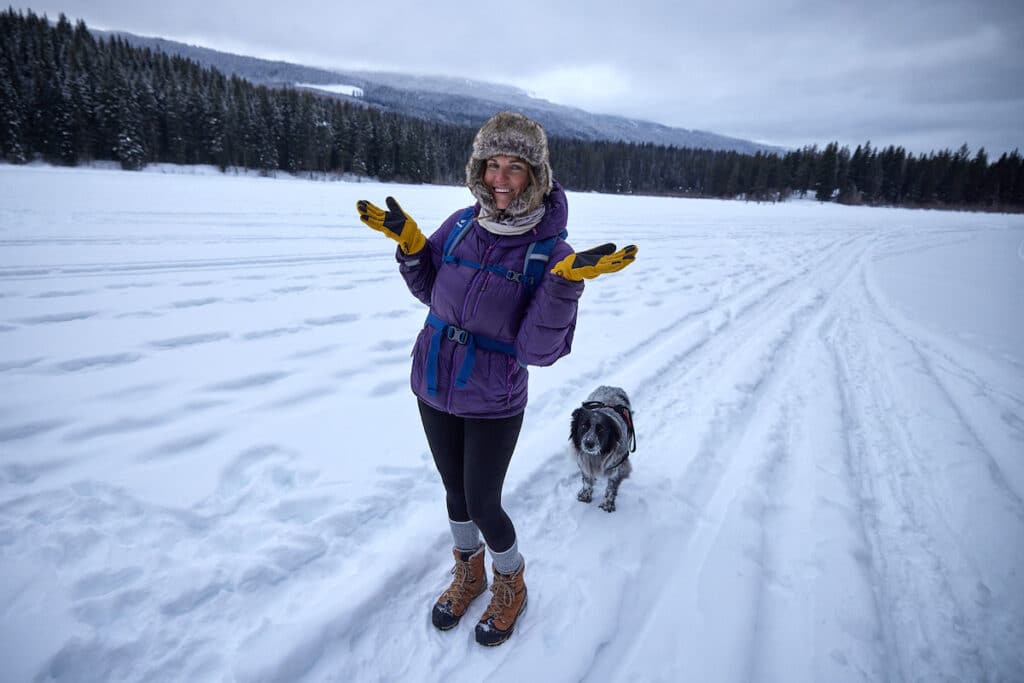
You’ll additionally need to concentrate on avalanche circumstances. This is of explicit concern within the Western US, and it’s not solely backcountry skiers that fall sufferer. Read to the top of this put up the place I share some particular ideas for avoiding avalanche hazard.
2. Get an early begin
Set your alarm! Daylight hours are shorter in winter, so hit the path early to keep away from being out at nighttime (which is generally is a lot extra harmful within the winter than in the summertime). Winter climbing additionally takes longer than summer season climbing – you have a tendency to maneuver slower and encounter extra obstacles. By beginning early, your danger of a tense scenario is minimized.
3. Have a dependable navigation software (and a backup)!
For climbing in snow, I counsel you carry map, compass, and GPS gadget. Snowpack can cover the path and path markers making it simpler to get misplaced. You’ll need to concentrate and know the best way to keep away from getting off-track.
While a paper map is finest, I do know that realistically most individuals (myself included) are likely to depend on their telephones for day hikes. Before starting your winter hike, be sure to obtain any maps and routes to your telephone so you should use them offline. That method if it’s essential to, you may put your telephone into airplane mode to preserve your battery and nonetheless entry your maps.
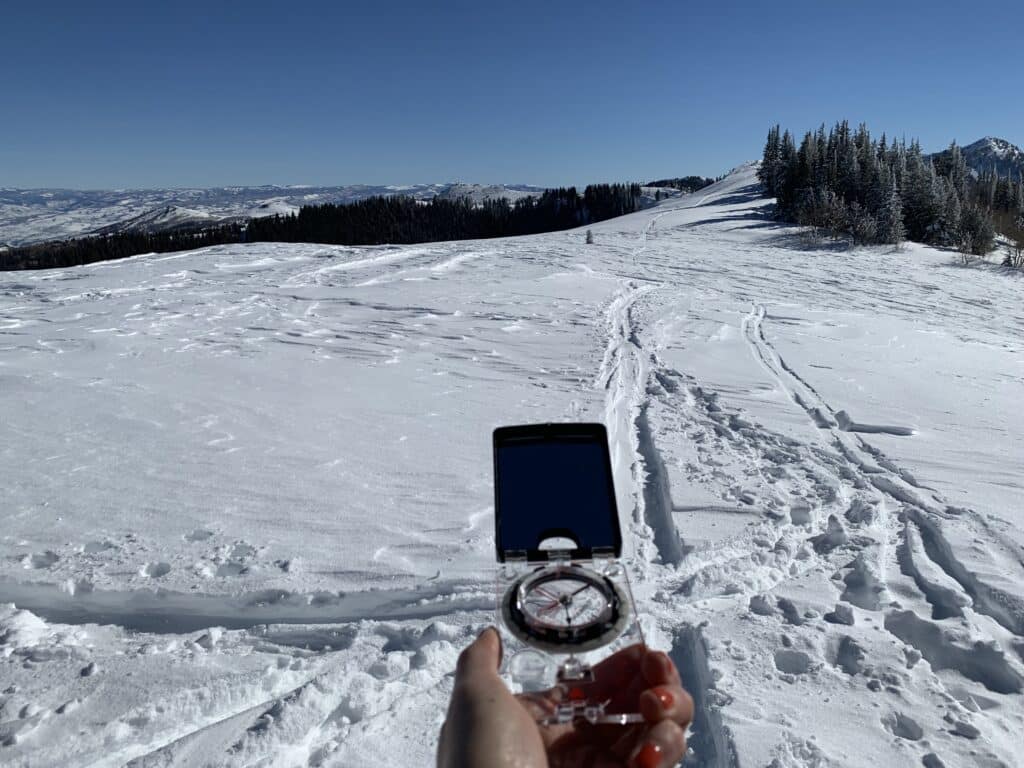
Also, digital gadgets are likely to go useless rapidly in chilly temperatures, so in case you plan to make use of your telephone for navigation, be ready by bringing further batteries/battery packs and attempt to hold your gadgets heat. You’ll additionally need some kind of backup for navigation, similar to a GPS or or Garmin Watch with preloaded topo maps, so that you aren’t relying solely in your telephone.
4. Carry a communication gadget
Depending on how far you’re out within the backcountry, you might not have cell service. My high winter climbing tip (and actually a tip for anybody who spends time exterior) is to spend money on a Garmin inReach Mini 2-way satellite tv for pc communicator. This permits for 2-way texts and provides you the flexibility to name for assist in case of an harm, an avalanche, or in case you get misplaced.
5. Tell somebody your climbing plans
While that is vital all yr spherical, a key winter climbing tip is to inform somebody your climbing plans. If one thing have been to go flawed, this might be your lifeline to assist. Your climbing plan ought to embody if you end up beginning and while you plan to complete your hike (and be again in cell service), the trailhead, your route, and who you’re climbing with. When you wrap up your hike, ship that individual a fast textual content and allow them to know you’re off the path.
Join our neighborhood for entry to our free member assets!
Download Handy Outdoor Packing Checklists & Trip Planning Guides
What to Wear Winter Hiking
The key to consolation when climbing within the winter is staying heat AND dry. If you begin to sweat and are carrying the flawed materials, you’ll find yourself moist and chilly. This means you’ll need to keep away from cotton and go for baselayers that wick moisture and are quick-drying as a substitute. Below are some recommendations on what I put on for winter climbing.
6. Dress in layers
What to put on on high
When climbing in chilly climate, it is best to have 3 layers on high plus a neck hotter. These are my go-to’s:

What to put on on backside
On the underside, you’ve obtained some choices. If it’s actually chilly or snowing, you’ll need to think about carrying a base layer and a water-proof layer over it. You may even put on ski pants. Otherwise, a pair of fleece leggings will do the trick, protecting you heat and cozy.
I share extra suggestions for ladies’s winter climbing attire right here.
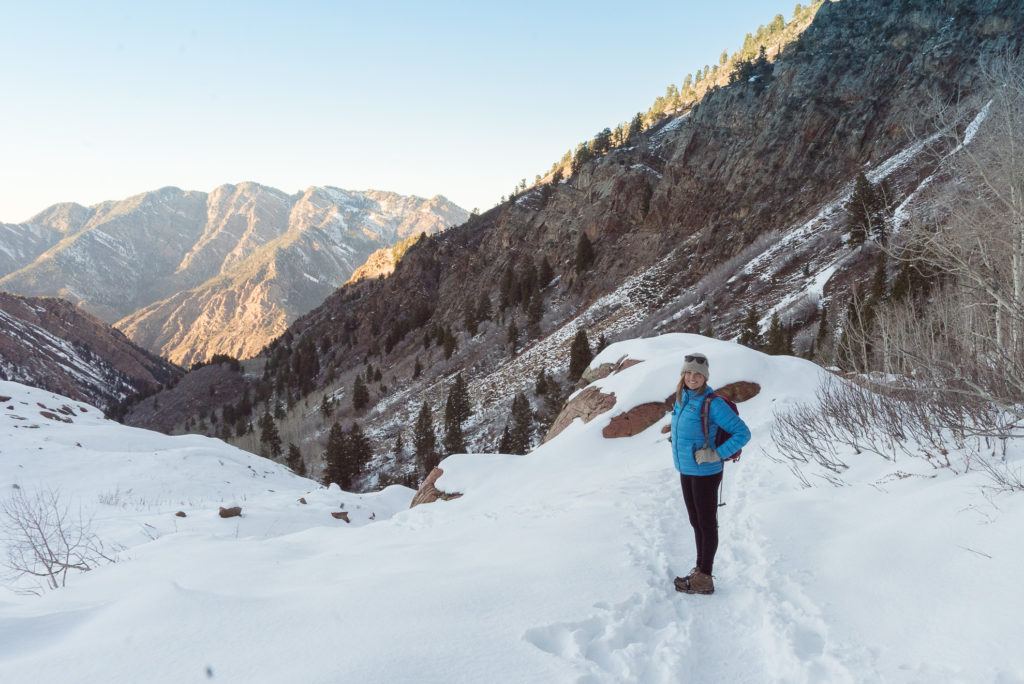
7. Adjust layers as typically as wanted
On the uphill sections of your winter hike, it’s vital to delayer in case you begin to get sweaty. All of that moisture will finally make you chilly while you get to the highest and it’s time to return downhill. The identical goes for including a layer as quickly as you begin to get chilly.
It might appear to be a ache within the butt to continuously cease so as to add or take off a layer, however being proactive in regulating your physique temperature will make sure you keep dry and cozy all through your hike.
8. Keep your extremities protected
When I hike uphill in winter, I discover my arms run heat, and I can typically hike with none gloves on. But as quickly as I flip round and hike down, my arms get chilly once more. Out of all the areas in your physique, your fingers are one of the vital liable to frostbite. This is why it’s vital to all the time pack a pair of gloves, even in case you don’t suppose you’ll want them.
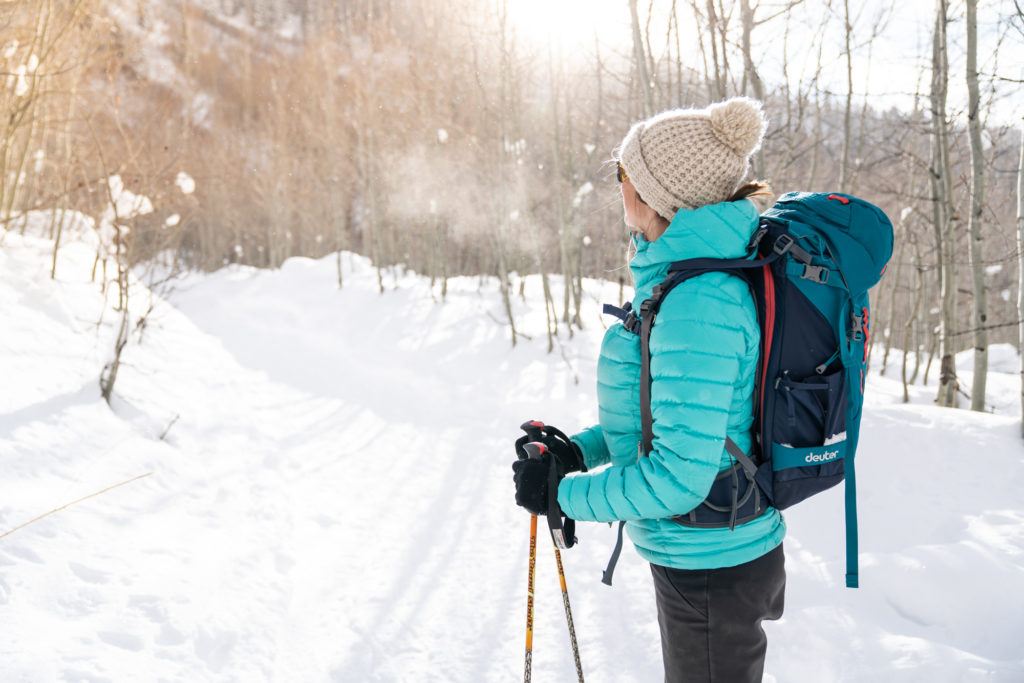
I like to recommend gloves which have touchscreen functionality. That method you don’t should take them off to make use of your telephone to navigate or to take pictures. Ideally, you additionally need your gloves to supply water resistance in case they get snow on them.
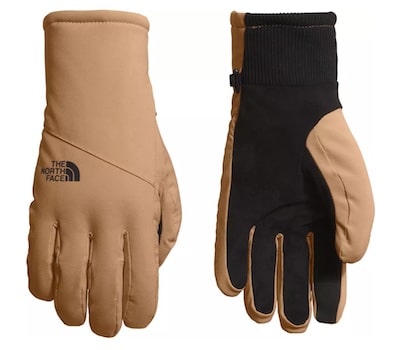
9. Pack a beanie AND a baseball cap
You lose a major quantity of warmth via the highest of your head. Wearing a hat is likely one of the most vital winter climbing tricks to retain your physique warmth. It additionally retains your ears protected against the wind. Even in case you don’t suppose you’ll want one, it’s good to hold one in your pack simply in case.
And whereas I’m a sucker for a cute beanie with a pom on high, it’s most sensible to carry a easy beanie that packs down small and doesn’t take up an excessive amount of room in your bag for while you don’t want it.
I additionally all the time pack a traditional baseball cap. On the uphill stretches, I simply overheat if I’m carrying a beanie, so I’ll swap it out for a baseball cap to maintain the solar off my face. Speaking of the solar….
10. Use solar safety
While sunscreen won’t be the very first thing you seize while you’re making ready for a hike within the snow, you’ll need to lather up. Snow can mirror as much as 90% of UV rays and might trigger fairly potent sunburns in case you’re not cautious.
Before you begin your hike, apply sunscreen to your face, ears, and some other a part of your physique that’s uncovered. Don’t miss the underside of your nostril close to your nostrils – a spot that’s infamous for burning as a result of reflection off the snow and is simple to miss. I additionally like to use chapstick with SPF to keep away from cracked and sunburnt lips.
Finally, carry pair of polarized shades that present full protection for the areas round your eyes.

11. Say no to cotton socks
If you occur to get snow in your boots, cotton socks will trigger your toes to remain moist and chilly for the rest of your hike. You might even get blisters. Instead of cotton, go for wool socks that insulate even when moist. My absolute favourite socks are made by Darn Tough Vermont. For winter climbing, you’ll desire a lengthy, thick pair, however not so cumbersome that your boots really feel too cosy.
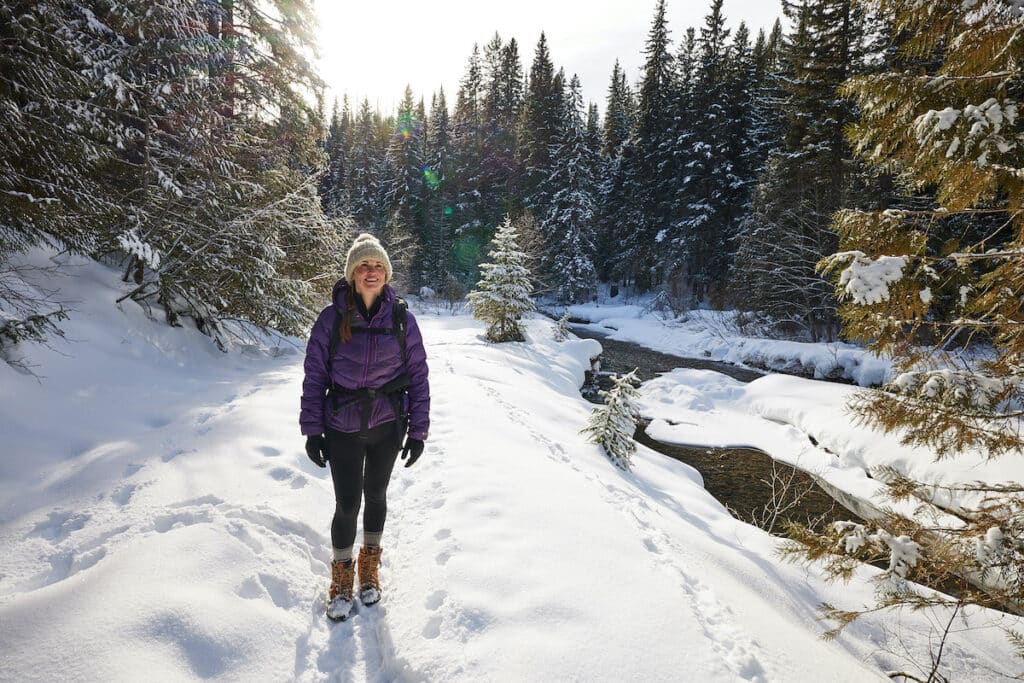
12. Wear insulated climbing boots
You could also be tempted to put on your regular climbing boots on a winter hike. If it’s chilly, however there’s no snow, then that doubtless might be high-quality. However, in case you are climbing in snowy terrain, you’ll thank your self for getting a pair of insulated girls’s winter climbing boots. Like your fingers, toes are additionally liable to frostbite, and when you get frostbite, it’s more likely to be a repeat offender. So for me, having a winter particular climbing boot that can final me a number of seasons is well worth the expense.
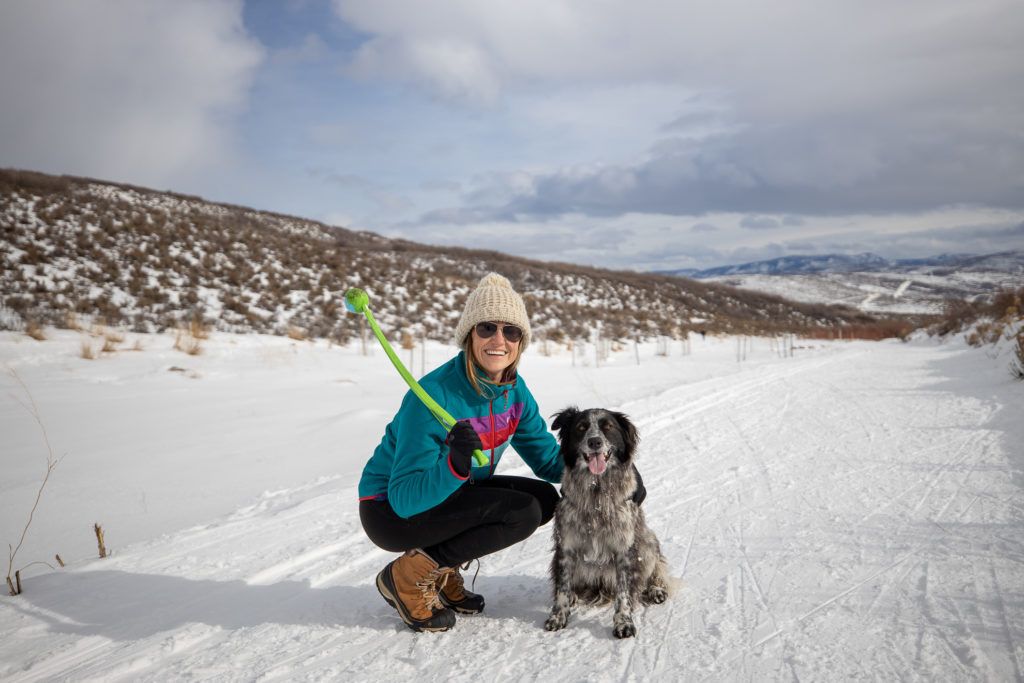
I personally put on the Oboz Bridger Insulated Hiking Boots (males’s winter Bridger boots right here). The girls’s (7″ cuff) and males’s (8″ cuff) have 200g of Thinsulate, and the insoles incorporate a thermal layer high and a mylar backside to additional insulate your toes from the chilly. The outsole can also be designed to offer grip in icy and snowy circumstances. You’ll nonetheless doubtlessly need microspikes (extra on that in a sec), however a winter climbing boot’s beefy lugs offers you extra confidence than your common ol’ summer season climbing sneakers.
Need extra suggestions? Check out my put up on the finest girls’s winter climbing boots.
13. Use gaiters to forestall snow from getting in your sneakers
If you’ll be traversing throughout ungroomed snow, put on a pair of gaiters to forestall snow from getting inside your boots. They simply clip on by operating a strap below your shoe, making a barrier to entry for snow falling into your sneakers. Gaiters will assist hold your socks and ankles dry, protecting your toes hotter as you winter hike.

How to Hike on Icy and Snowy Trails
So you bought your winter layers down. Now I’ll cowl the vital winter climbing gear that makes it simpler to hike on ice and snow.
14. Consider whether or not you want snowshoes
This winter climbing tip I realized the exhausting method. Lugging snowshoes round might appear to be a ache, however snowshoes are available in very helpful for climbing in snow. A few years in the past, Ryan and I have been in Fernie, British Columbia on a Powder Highway street journey. We rented snowshoes at an area store and ready for a enjoyable day exterior.
Once we obtained to the trailhead, we took a take a look at the path, and in opposition to the recommendation of the store workers, we determined we didn’t want the snowshoes. We left them within the automobile and set out. At first, it was high-quality. The path was agency, however not icy, and we have been proud of our alternative.
But as soon as we obtained simply far sufficient from our automobile, the path began to get softer. Before we knew it, we have been post-holing (sinking down into the snow with every step) like loopy, and Ryan really ended up actually hurting his knee. The hike ended up taking endlessly and will have doubtlessly ruined the remainder of our journey. Never once more!
Of course you don’t want snowshoes on each winter hike, however in case you plan to take the path much less traveled – one which isn’t plowed or packed down as a result of foot site visitors – snowshoes are extraordinarily useful. And the excellent news is, they’re method lighter and extra environment friendly than they was once.

Snowshoes are mild and huge frames that connect to your shoe, splendid for climbing on deep snow. By rising the floor space of your toes, you’re in a position to float on high of the snow with out sinking in too deep.
When selecting a pair of snowshoes, you’ll need one thing designed for the terrain and circumstances that you just sometimes encounter on a winter hike. For smooth, deep snow, you’ll desire a longer snowshoe, whereas a shorter snowshoe is ideal in case you sometimes keep on with densely packed trails.
If you’re on the lookout for an all-around versatile snowshoe that’s environment friendly on the paths, however can nonetheless carry out in deeper snow, the MSR EVO Ascent Snowshoes are an important alternative. At 22″ lengthy, they gained’t make you are feeling clumsy on consolidated snow, and if you find yourself spending loads of time off-trail, MSR sells some add-on tails that stretch the size for improved floatation.
You’ll need to pair your snowshoes with a set of trekking poles with interchangeable ski baskets so while you plant the pole, it doesn’t sink into the snow.
For extra on snowshoeing, see my information to Snowshoeing 101.
15. Use microspikes or crampons when the path is icy
Winter climbing typically means you would possibly encounter ice on the path, and microspikes can add an enormous quantity of traction to forestall slipping, particularly on trails the place snowshoes are overkill.
Microspikes are product of chains and tiny spikes that slip on over your boots. The Yaktrax Pro Traction microspikes are cheap, they usually make a world of a distinction.
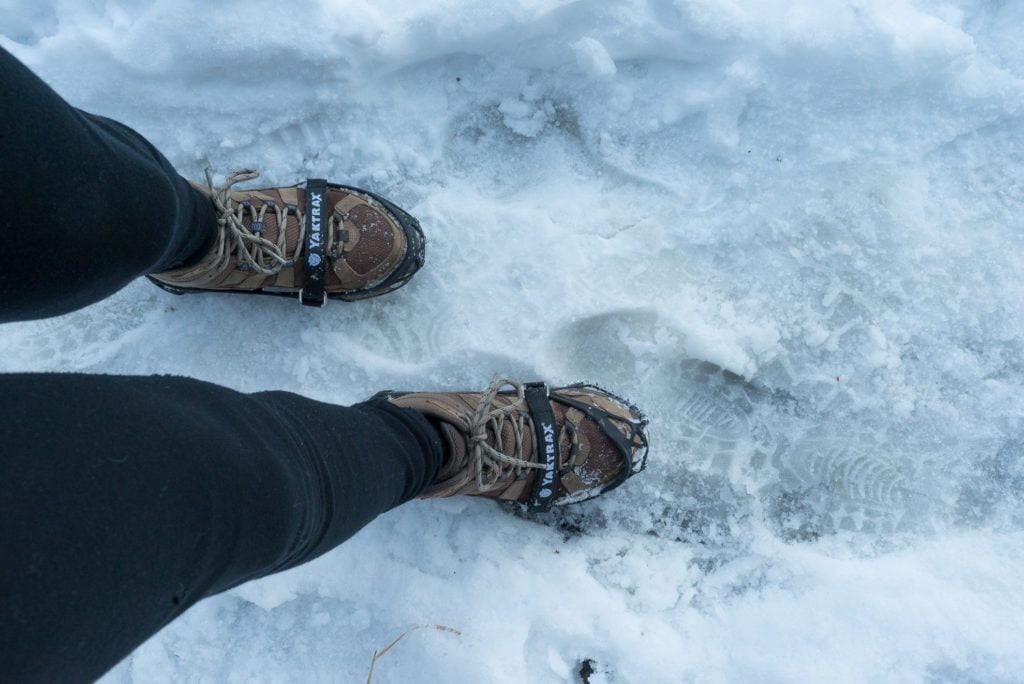
If you want one thing beefier for steeper terrain, crampons are a bit extra sturdy with larger spikes that grip into ice, making them particularly useful on steep, slick inclines. It’s good to have the ability to pop these on and off while you want them as a result of they add some weight to the shoe and aren’t that snug to stroll usually on.
The Petzel Leonard FL Crampons are good entry-level crampons which might be light-weight and straightforward to connect and take away out of your winter boots.
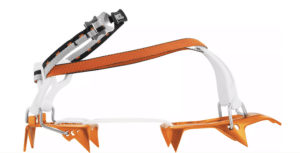
16. Stay off frozen lakes and rivers
It’s very exhausting to inform how thick the ice is over frozen lakes and rivers, so keep off the ice and away from our bodies of water when climbing in winter. When climbing in chilly climate, it’s all the time finest to play it secure.
Other Winter Hiking Tips
You might be extra snug staying energetic outdoor in the course of the winter if in case you have applicable winter layers for climbing as I shared above. But, there are extra steps you may take to remain heat that may make a giant distinction in your potential to control your temperature.
17. Bring a heat drink in a thermos
One of my favourite winter climbing ideas is to refill an insulated thermos, like this 20oz Stanley Trigger Action Mug , together with your favourite scorching beverage. Hot cocoa, cider, chai tea, and even soup broth is nice for fast sips to heat you up on the path.
While I most likely don’t have to say it, go with out alcohol on cold-weather hikes as alcohol reduces your physique temperature. You can take pleasure in that scorching toddy when you’re again at house!
18. Stay hydrated
Dehydration expedites the onset of hypothermia, so keep hydrated. If you are feeling thirsty, it’s time to drink up. Even higher in case you throw in some electrolytes (Nuun Tablets are a straightforward, tasty repair for replenishing your electrolytes).
On 99% of my hikes, I exploit a hydration reservoir to make it straightforward for me to drink water with out stopping. The drawback with utilizing a hydration reservoir on winter hikes is that if it’s chilly sufficient, the water within the hose can freeze (or on the very least, the water might provide you with mind freeze).
To fight this, you may both refill your reservoir with heat water or you should use an insulated hydration reservoir that can stop your water from icing up.
19. Choose sunnier trails
In the summer season months, you need to select shady trails to keep away from the blazing solar. In the winter, it’s the other. For winter climbing, strive to decide on a path that will get some respectable solar publicity. Thick evergreen forests are going to be so much colder than a forest the place the leaves have dropped and the solar can penetrate or a path that traverses extra open terrain.
Remember that the solar units fairly early in winter (normally by 5pm in most locations within the US)! As quickly because the solar drops behind the mountains and the path turns into shady, temperatures can drop considerably.
If you intend on catching the sundown, we suggest not being too removed from the trailhead and ensuring to pack further layers.
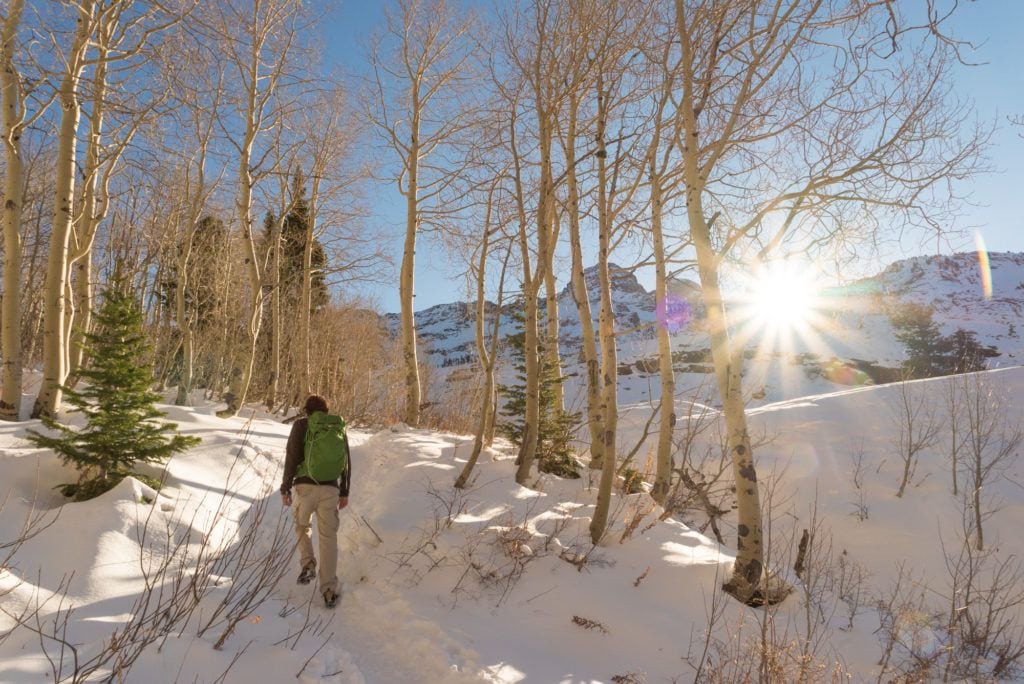
20. Choose trails with some uphill
Just like climbing stairs, the uphill sections of your winter hikes will get your coronary heart pumping. This helps to extend your circulation and lift your inside physique temperature, which is able to hold you good and toasty. This is particularly useful in case you begin your hike within the early morning when the temps are actually chilly and the solar isn’t out but.
If you do get sweaty on the uphill sections, it’s vital to put on sweat-wicking, quick-drying base layers and delayer earlier than you get too moist.

21. Bring easy-to-eat snacks
Exercising in winter burns extra energy as a result of your physique burns energy in its efforts to remain heat. Staying nourished on the path is a crucial winter climbing tip, and I counsel you pack snacks which might be excessive in protein and carbs to present you power.
It’s vital that the snacks you carry for climbing on snow are fast and straightforward to eat whereas on the transfer. Leave the sandwich fixings and picnic at house. You need to make your lunch cease fast since your muscle groups should work more durable to heat up once more. Check out my roundup of the most effective straightforward climbing snacks for concepts.
Another choice if you wish to eat one thing heat is to make some soup, chili, or mac and cheese at house. Throw it in a thermos and pack your favourite spork for a fast pick-me-up.
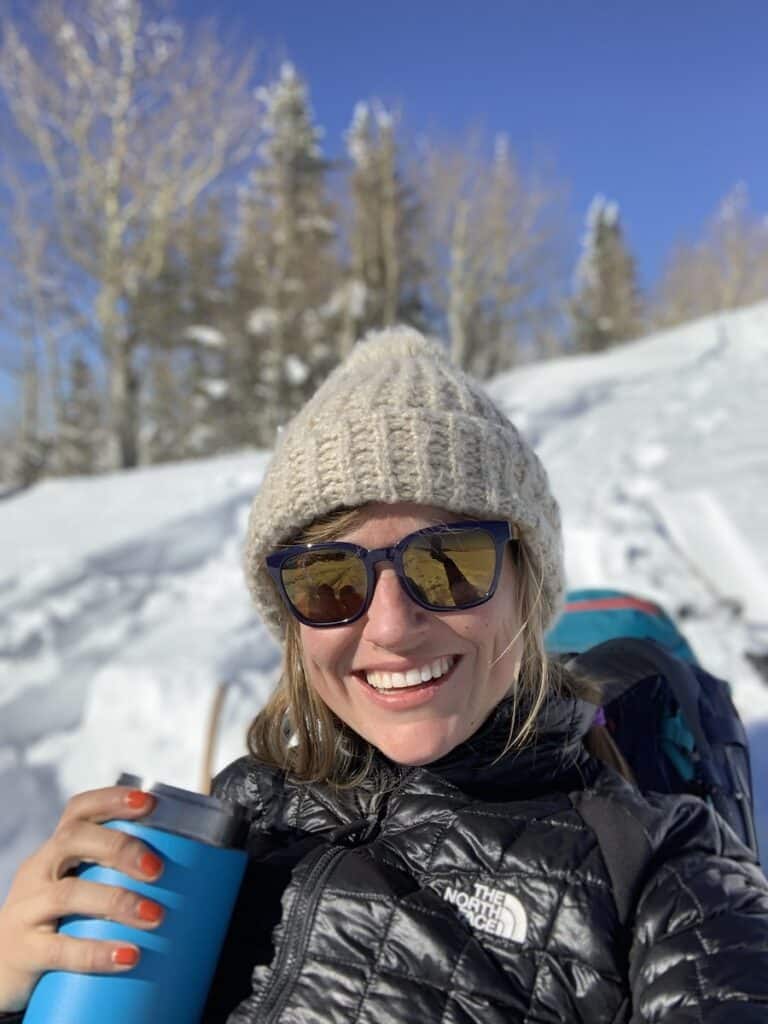
Safety Tips for Winter Hiking
Safety is the primary precedence at Bearfoot Theory as a result of it ensures that you just, your pals, and everybody else can have time exterior with fewer worries.
22. Have a winter climbing security plan
Hiking in snow all the time begins with a strong security plan. Here are a number of vital tricks to observe:
- If you’re in a gaggle, base the plan on the least skilled/in a position individual.
- Always inform somebody your plan: the place you’re headed, your estimated return time, who you’ll be with, and so forth.
- Be ready for worse climate than the forecast requires, simply in case.
- Be practical about your objectives. If you’re new to winter climbing, begin small so you may acquire confidence in your ability set earlier than you deal with more difficult trails
- Make certain you’re snug utilizing any technical winter climbing gear you carry (like a beacon)
- Have a hard-set flip round time that you’re dedicated to starting your return to your automobile. That method you don’t get caught out after darkish
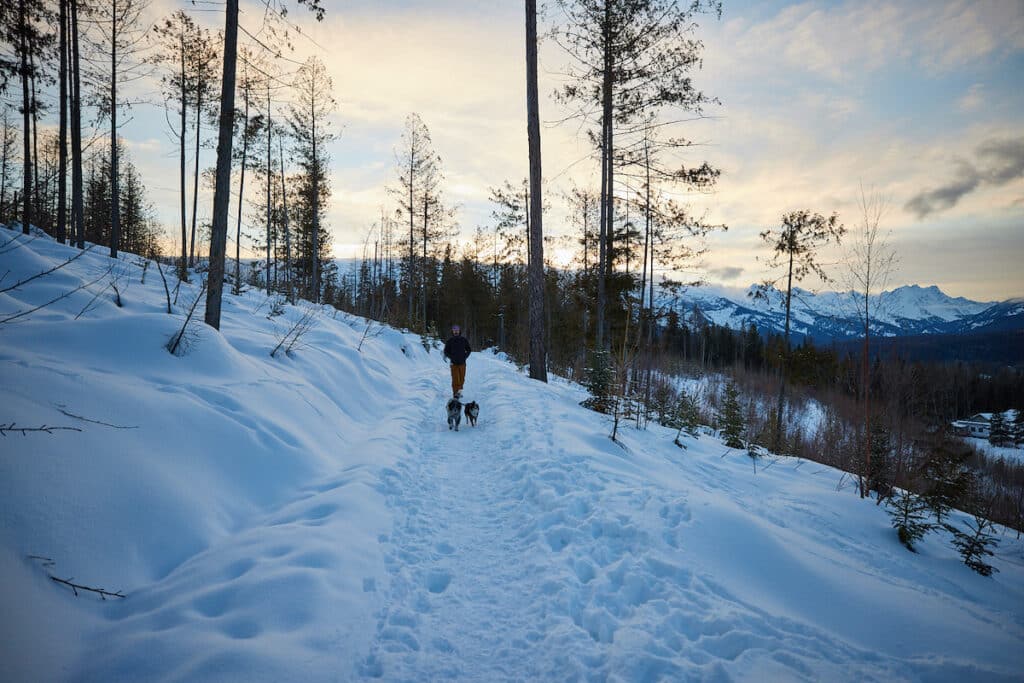
23. Pack the ten necessities
While you might go away a few of these at house in the summertime, in winter, you actually need to pack the ten Essentials for Hiking. The penalties of a mishap can exponentially enhance in case you don’t have the right security gear. While I’ve coated a few of these objects within the earlier winter climbing ideas, right here’s the complete record of the ten Hiking Essentials as a refresher.
- Navigation
- Headlamp
- Sun safety – sunscreen, hat, sun shades
- First Aid Kit
- Knife/Multitool
- Way to start out a fireplace
- Shelter/emergency bivy
- Extra meals
- Extra water
- Extra layers
Unlike summer season when you will get away with a 10-15 liter day pack, in winter, it is best to plan to carry a bigger climbing pack that may match all the 10 climbing necessities. The Osprey Tempest is one among my favourite daypacks for climbing (the boys’s model is the Osprey Talon). If you’re climbing in avalanche terrain, a backcountry ski pack particularly could have a pocket that makes it straightforward to entry your shovel and probe.
24. Know the indicators of hypothermia
Hypothermia happens when your physique’s core temperature decreases to a stage during which regular muscular and cerebral capabilities are impaired. Hypothermia can have an effect on your potential to suppose clearly in addition to your potential to evacuate rapidly to security.
Before you go climbing in winter, it’s vital that you realize the warning indicators and are in a position to acknowledge them in case you or a pal begin to present signs of hypothermia.
Conditions That Can Lead to Hypothermia:
- Cold temperatures
- Improper clothes and gear for altering climate circumstances
- Wetness
- Fatigue, exhaustion, dehydration, insufficient meals consumption
- Alcohol consumption expands your blood vessels which might lead to elevated warmth loss
Symptoms of Hypothermia:
- Uncontrollable or violent shivering
- Slurred speech or incapacity to speak
- Fumbling or feeling torpid
You can learn extra info on treating and stopping hypothermia right here.
25. Know (about avalanche dangers) earlier than you go
“Know Before You Go” is a typical saying in avalanche coaching programs, and it’s precisely that – know the avalanche circumstances earlier than you head out. While this doesn’t apply in every single place, it’s actually vital out West the place slopes are steep and could be liable to sliding.
A vital winter climbing tip when planning to hike within the snow is to do your analysis, keep away from avalanche terrain, and keep house on high-risk days. Your finest supply of data is the native avalanche forecasting workplace or the close by Ranger Station.
Avalanches aren’t simply one thing backcountry skiers want to concentrate on. Anyone who’s spending time within the mountains in winter ought to take the time to grasp some avalanche fundamentals so you may keep away from unknowingly climbing on or under high-risk avalanche terrain.
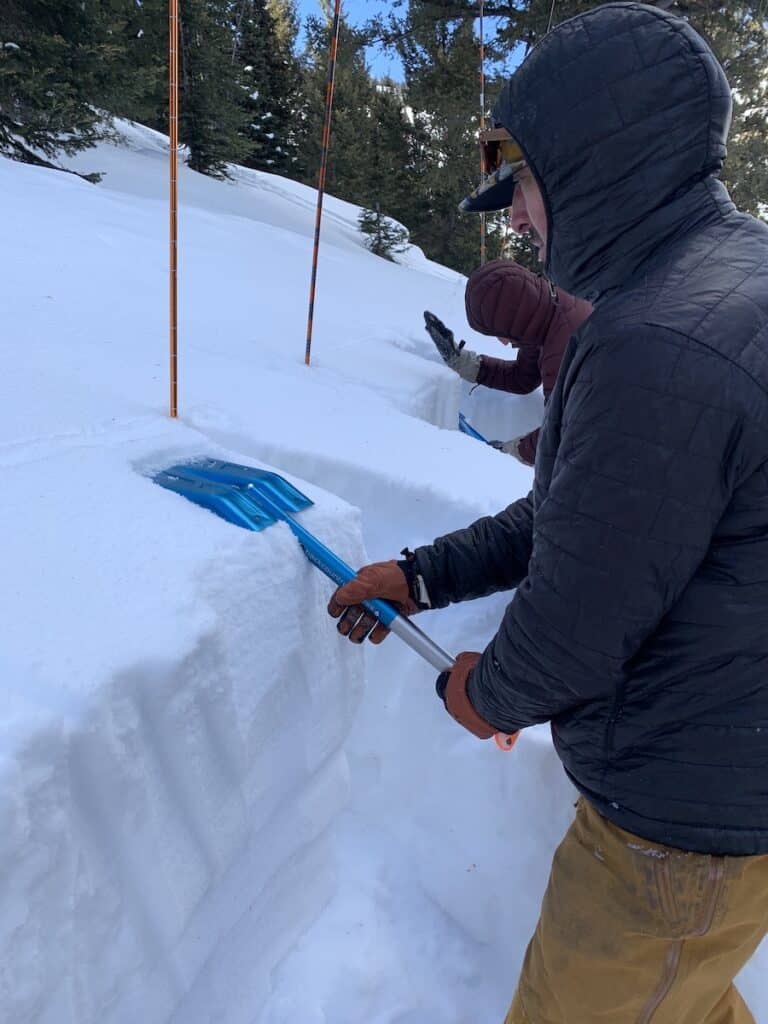
The two main sorts of avalanches are unfastened snow and slab. Loose-snow avalanches can happen in moist or dry snow, starting close to the floor and gathering extra snow as they slide. Slab avalanches, just like the one pictured under, happen when a complete shelf of snow breaks free and slides down the mountain – these are probably the most deadly.
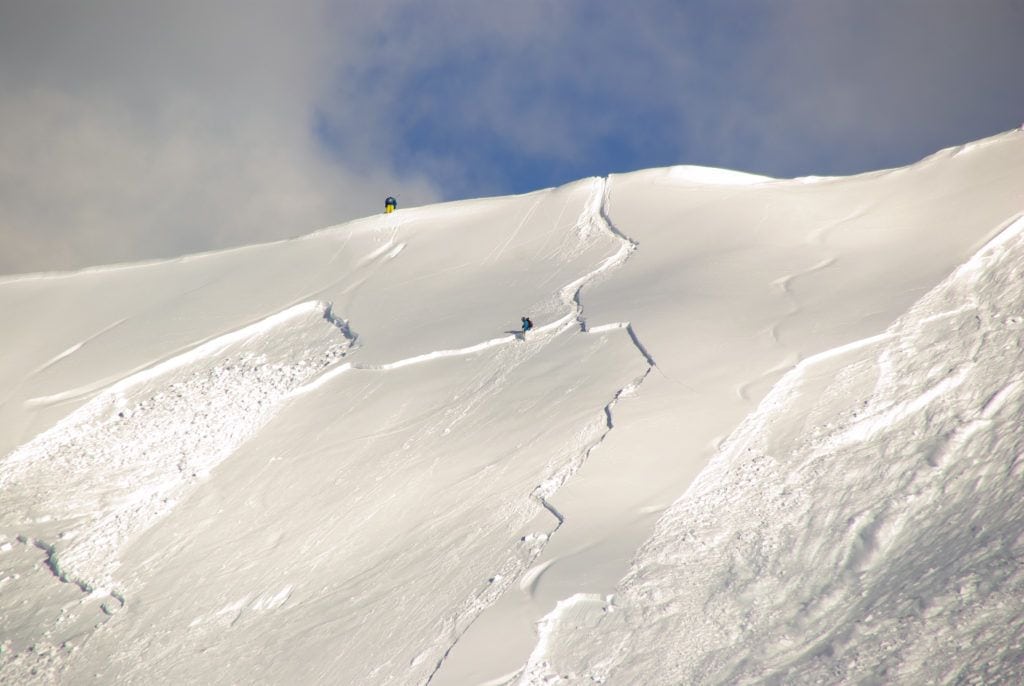
Avalanches are the results of a mixture of 4 various factors: a steep slope over 30 levels, snowpack and climate circumstances, a weak layer within the snow, and a set off. Triggers could be pure, similar to wind, or human induced.
While we don’t have management over terrain or circumstances, we do have management over ourselves. So, it’s crucial that you just and your climbing companions perceive the following pointers for avalanche security so that you keep away from placing your self at risk.
- Check circumstances earlier than going. Avalanche.org is a dependable web site that hyperlinks to native forecasting workplaces across the US. Before you intend to hike within the snow, this can be a good place to start out to ensure snow circumstances are steady.
- Just since you see footprints or different individuals on a path doesn’t imply it’s secure.
- Do not take dangers in terms of climbing in snow. Plan your route earlier than you allow the home in an effort to keep away from climbing on or under terrain that’s liable to sliding.
- Group pondering can cloud your judgment – belief your intestine. If one thing doesn’t really feel/appear proper, communicate up. Communication is essential.
- It’s okay to show round earlier than reaching your objective vacation spot. Many accidents occur when individuals forego their higher judgment as a result of they’re too dedicated to reaching the objective.
While not vital for mellow winter trails, in case you plan to continuously hike round steeper winter terrain the place avalanches are potential, it is best to spend money on avalanche gear. This features a beacon, probe, and shovel.
A beacon is a vital piece of backcountry winter climbing gear that permits search and rescuers to seek out you in case you have been ever in an avalanche. You can even use a beacon to seek out others who’re buried by an avalanche in the event that they too are carrying a beacon.
A probe is a software that permits you to pinpoint the situation of somebody who has been buried by an avalanche, and the shovel is the way you dig them out. If you do get a beacon, probe, and shovel, discover ways to use these instruments and get actually snug with them earlier than venturing into the backcountry.
After studying this whole information stuffed with winter climbing ideas, I hope you are feeling assured to exit and benefit from the outdoor this winter! Winter is a stupendous time to expertise a distinct aspect of nature and I hope you are feeling assured and impressed to get on the market.
Get extra recommendation for winter climbing in these posts:
Save this put up to Pinterest
Related Posts



